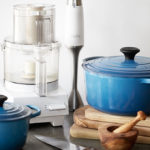
These are my frozen supplies. Ends from alliums, carrots, mushrooms and more. A frozen carcass of a whole chicken.

Fresh veggies together with the frozen ends transferred to a 100% cotton straining bag that will go right in the pot. I was missing a carrot for this batch–thankfully there was some carrot ends in the frozen bag!

Ends discarded, stalks scrubbed and roughly chopped.

The whole lot combined with bay leaf, peppercorns, salt and apple cider vinegar.

Here are a couple of the jars this batch produced. As you can see I leave plenty of room at top to prevent cracking in the freezer.
The more collagen and marrow the better
You can make a healthy and delicious broth from the bones of virtually any animal, but it’s best if you can get chicken feet or trotters for collagen and ruminant bones with marrow. This is the stuff that makes ‘chicken soup’ known for its healing properties. If you have neither of these available to you, the carcass of a whole chicken with the skin is an easy go to.
If you’re not sure when you’ll get around to cooking a whole chicken, then save any bones from wings and legs by storing them in the freezer until you’re ready to make your broth. As in the first photo above, they’ll do best stored in a parchment paper lined plastic ziplock bag. This is also a good way to reserve any ends of carrots, parsley, alliums, skins of garlic, onions or mushroom stems to create an extra flavorful and nutritious broth. The skins of onions and garlic in particular are packed with powerful nutrients. The more you can simmer down the better!
Cooking Notes
Cook the broth on very low heat for as long as you can stand it
My mother only simmers her broth for about 3 hours, but traditionally you would let the broth simmer for 12 or even 24 hours. The longer you let it cook, the more healing and nourishing goodness is drawn out out of the bones.
Put all the veggies in a 100% organic cotton straining bag
This little trick will dramatically ease the process of transferring the broth to storage containers. Once the broth is completely cooled, squeeze the bag to strain any remaining juices. Turn the bag inside out to dump the contents and rinse in the kitchen sink before putting it into the laundry. You’ll want to have a dedicated “savory cooking” bag, to avoid having your nut milk or dairy infused with a hint of broth! Be sure to buy a bag that’s 100% cotton and organic.
Once you’re done cooking
Let the broth sit and cool. This may take a few hours. Once it’s lukewarm, use a stainless steel mesh strainer while transferring the broth.
Store in glass jars–not plastic containers. Between the acids in the broth and the warmth of the liquid, plastic toxins will leech toxins into your carefully prepared health elixir. Leave plenty of room at the top to prevent the jar from cracking in the freezer.
These Weck jars are excellent for broth with their super wide mouths, but if you prefer the security of a screw top Ball jars are a much more affordable option.
If you’ve never used glass jars to store liquid in the freezer run a test with lukewarm water. Pour as much water into the jar as you plan to fill with broth, leaving about 2 inches of space. This may sound ridiculous, but I’ve had a few people mention that their jars crack to their dismay. I’ve only ever had that happen when I overfilled. This test should prevent you from loosing any jars of that precious golden broth!
Place as many jars as you’ll use in a week or two in the fridge, and freeze the rest. I like to pour jars of varying sizes to suit various recipes. Sometime you only need a few ounces, such as for sauces, grains or to fortify a small batch of soup.
Images from a previous batch with a marrow rich bone

Here you have a great bone chock-full of marrow. Makes for great tasting and nutrient dense broth.





